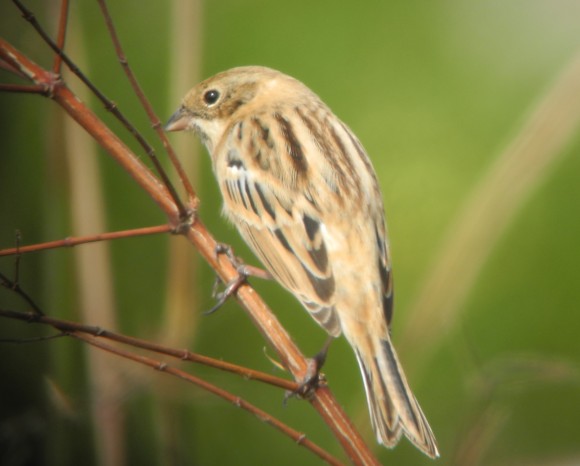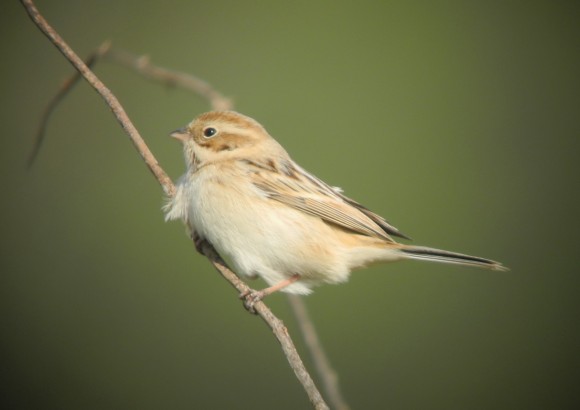Selected Bird Survey highlights from Nial Moores
In total 111 species were recorded during this period (out of a grand total of 146 species recorded on Gageo between October 21st and November 7th). Counts were made daily along the 1-Gu Circuit, and also in 2-Gu on 5th and 6th. Between 63 and 85 species were recorded each day, with 85 and 80 species recorded on the 5th and 6th respectively. Although the 2nd and 3rd were dry with winds between the north and east, several hours of rain during the morning of November 4th and some light rain on 5th were followed by strong westerly and north-westerly winds, moderating on the 7th (the last morning of fieldwork). This same weather system grounded a large number of migrants, including several Japanese-type species (i.e. several Grey Thrush, Yellow Bunting and two Japanese Grosbeak) and large numbers of Dusky and Eye-browed Thrush. It therefore showed several similarities to a late autumn fall on Socheong on November 11th 2004 (see http://www.birdskorea.org/Birds/Birdnews/BK-BN-birdnews-2004-11.shtml). Highlights (with all images taken with a hand-held Nikon P7100 through a SUPERB Swarvoski scope) included:
Japanese Quail: Recorded daily, with six on 5th the highest count.
Common Merganser: One on November 2nd was perhaps the first record for Gageo.
Dunlin: One on November 4th was perhaps the first record for Gageo.
Lesser Kestrel: One probable was watched apparently coming in from the east, before gaining height, in the late afternoon of the 3rd Identification was based on its whitish-looking underwings with broad blackish primary tips; its weak facial markings, lacking an obvious “moustache” (although only seen with binoculars); and its slightly wedge-shaped tail, with prominent, longer central tail feathers. No images were taken, and all views (over less than one minute) were at moderate to long-range, at one time directly from below. There have been several claims of Lesser Kestrel in late autumn on Gageo, and one further claim from the mainland (in Gyeonggi), none supported with images.
Amur Falcon: The same individual first found on October 31st was still at 2-Gu on 5th and 6th.
Yellow-bellied Tit: Only recorded once during the period: a high-flying single was seen and heard trying to depart west from the island on 7th.
Light-vented Bulbul: Although only first-recorded in the ROK on October 29th 2002 (on Eocheong), this species now breeds on several islands, and has been recorded throughout the year on Gageo. Although at least 25 were present in late October, the highest count was of only 13 in 1-Gu and 2-Gu combined in November (suggesting at least some emigration from the island during this period).
Chinese Nuthatch: One was present (but elusive) in the 1-Gu quarry, last being seen on the 4th.


Common Starling: One was with four White-cheeked Starling in 1-Gu on the 7th. This species remains a very scarce winter visitor to the ROK, apparently most regular on Jeju.
Grey Thrush: Two were in 1-Gu on 4th, with further singles found in 2-Gu on 5th and 6th.
Eye-browed Thrush: Approximately 700 were seen at midday on the 4th, with perhaps as many as 1,000 (out of the 1,700 thrushes seen during a 5-minute departure) departing the island at late dusk.
Dusky Thrush: Small numbers seen daily from the 4th, with 50+ seen on the 4th during the day, and probably several hundred involved in the mass thrush departure that evening.

Mugimaki Flycatcher: Eight in 1-Gu on November 3rd was the highest recorded count of the species on Gageo during this 17-day period.
Verditer Flycatcher: One was seen briefly at long-range on 7th – the fourth record of the species on Gageo, and the third Verditer recorded on the island this year.
Scaly-breasted Munia: Between two and four were recorded between the 5th and 7th in two parts of 1-Gu. This is the first record for Gageo, and the fifth national record (last being recorded on Jeju, on November 14th 2009). Their arrival followed several records far to the north of their mapped range in Hebei and Shandong this autumn (via Jesper Hornskov).
Yellow-breasted Bunting: Three on the 5th and 6th and one on the 7th.
Yellow Bunting: Two on the 4th, at least four (and perhaps as many as six) on the 5th and one on 6th are remarkable considering the near-lack of records in the ROK of this species during southward migration.


Pallas’s Reed Bunting: The second commonest bunting (after Yellow-throated), with 53 counted on the 6th. Several of the individuals seen on 6th and 7th appeared unexpectedly washed through with brown (especially on the underparts).
All images © Nial Moores/Birds Korea






